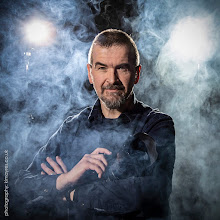Stealing My Soul...
"Are you in Dumfries for the wet-plate photography?"
"What? Where?"
"Up at the old Baker’s Oven, by WH Smiths. It’s part of the D-LUX festival."
*Insert image of cup and saucer hovering in mid air as photographer has shot out of the café and raced up the road in a whirlwind of excitement...*
Taking over an empty shop for the week, Concursum – a group of of three alternative photography practitioners and artists – had set up lights, old cameras and portable darkrooms and were creating portraits of the general public using the Collodion process – one of the earliest forms of photography.
It requires coating a piece of glass with the right solution, adding silver nitrate, placing it into the camera, exposing the shot for around 4 seconds and then developing it straight away.
Everything has to happen within about 10 minutes from start to finish, before the coatings dry and render the process useless.
Here’s a short video I found online which gives a flavour of how it’s done
Wet Plate for fstoppers from LeClair Photo + Video on Vimeo.
I got chatting with Laura Peters, a portrait and wedding photographer who has a complete fascination with it, and was one of the three practitioners. We instantly clicked as we started talking about our love of portraiture, and if wasn’t for the fact there were other people waiting, and I had a limited amount of time before I had to get home, I think we would have blethered non-stop for hours, if not days.
Initially I hadn’t intended to get my photo taken as I didn’t really have the time, but as I started to find out about it, I couldn’t resist. The rest of the afternoon would just have to be delayed.
Laura wonderfully talked me through the process, took my photo and then – the best part of all – allowed me to watch the "fixing" process, where the portrait emerges on the glass plate.
It was really quite magical.
I am completely a photographer of the digital age. I can take up to 11 photos a second if I want, using a hand-held camera designed for speed, accuracy and portability, and Photoshop is my darkroom.
This, on the other hand, is a process from more than 150 years ago. It is slow, cumbersome and completely unforgiving. One tiny error and you have to start the whole thing all over again.
I wouldn’t have the patience to do it myself, but then this allowed me to just be a punter for the first time since I became a photographer. Because I’m a professional photographer, if someone else takes my photo, I’m always analysing and comparing and thinking what I might do differently.
But with this, the process was so alien, all I could do was sit back, follow instructions and trust the photographer.
Here’s a copy of the final image.

My first thought was how much I looked like my Dad.
I think because the image immediately looks very old - even though as I write this it’s only 2 weeks since it was taken - it creates a kind of dissociation. It surely can’t really be me – so I cast around in my mind for who else it might be, and my father’s face is the next most similar to my own.
If you ever get the chance to have a go, you really must. It is a magical process and thoroughly worth that little bit of your soul it captures...






Post a Comment